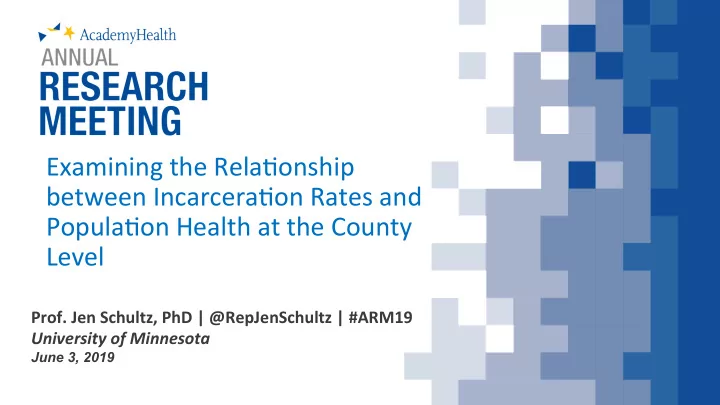

1 Examining ¡the ¡Rela.onship ¡ ¡ between ¡Incarcera.on ¡Rates ¡and ¡ Popula.on ¡Health ¡at ¡the ¡County ¡ Level Prof. ¡Jen ¡Schultz, ¡PhD ¡| ¡@RepJenSchultz ¡| ¡#ARM19 ¡ University ¡of ¡Minnesota ¡ June 3, 2019
Overview 2 • Purposes of study • Add to the growing body of knowledge about the collateral consequences of mass incarceration • Examine the relationship between level of incarceration and health outcomes at the county level @RepJenSchultz | #ARM19 | @AcademyHealth
Context 3 “The individual-level effects of incarceration … ripple outward” (Clear, 2008, p. 99) • The incarcerated individual à members of their families à the communities they are from @RepJenSchultz | #ARM19 | @AcademyHealth
Examining the Link between Incarceration and 4 Health Outcomes • Individual – Individuals with a history of incarceration report more chronic health problems post-incarceration(Schnittker & John, 2007) – Those who had been incarcerated disproportionately suffer from infectious diseases (Massoglia, 2008) – Women (but not men) with a history of incarceration are more likely to die earlier than those without such a history (Massoglia et al., 2014) • Family – Many of the harmful effects of incarceration on children’s health operate indirectly through other mechanisms (Massoglia & Pridemore, 2015) @RepJenSchultz | #ARM19 | @AcademyHealth
Community / Population Health Outcomes 5 • Given its unequal distribution across demographic groups in the population, incarceration may have implications for class /ethnic inequalities in children’s health at the population level (Turney, 2014; Wildeman & Wang, 2017) @RepJenSchultz | #ARM19 | @AcademyHealth
Incarceration & Health: State-Level Analyses 6 • Wildeman (2011) found that imprisonment is significantly associated with poorer population health, defined as infant mortality and female life expectancy • Wildeman (2012) found a positive association between imprisonment rate and the total infant mortality rate, black infant mortality rate, and black- white inequality in infant mortality @RepJenSchultz | #ARM19 | @AcademyHealth
The Present Study … 7 • … examines the relationship between incarceration rates and two indicators of health outcomes at the county level @RepJenSchultz | #ARM19 | @AcademyHealth
Analytic Strategy 8 Rate of incarceration is an endogenous variable • Many of the same factors that affect level of incarceration also affect population health – If endongenity is not accounted for, parameter estimates will be biased, overestimating the effect of incarceration rates on public health outcomes @RepJenSchultz | #ARM19 | @AcademyHealth
Analytic Strategy 9 To address the endongenity of incarceration rate, we use a 2-stage modeling strategy Estimate predicted incarceration rate in a multivariate 1. model including the exogenous “instrumental” variable per capita expenditures on incarceration o Exogenous variable – a factor that predicts incarceration rate, but not population health Use the predicted value of incarceration rate from the 2. first model in a multivariate model predicting health outcomes @RepJenSchultz | #ARM19 | @AcademyHealth
Data Sources 10 This study is based on information from three county-level sources Vera’s In-Our-Backyards data set, for 2015 1. Incarceration rates, urbanicity, UCR Index crime rate o County Health Rankings & Roadmaps (CHR&R) data, for 2. 2015 Public health factors and outcomes o U.S. Census Bureau data on expenditures, 2012 3. Per capita spending on corrections and community and o public health care A 3-year lag period was used to account for o hypothesized effects on correctional populations and health outcomes @RepJenSchultz | #ARM19 | @AcademyHealth
11 Model 1, Predicting Incarceration Rate • Per capita correctional spending was one of 8 independent variables in this OLS model • The coefficient for correctional spending was positive and significant (p < .001) @RepJenSchultz | #ARM19 | @AcademyHealth
Health Outcome Models: Description of 12 Variables Item ¡ Mean ¡ Years ¡of ¡potenAal ¡life ¡lost ¡(YPLL) ¡(rate ¡per ¡100,000) ¡ 7,996.3 ¡ • Dependent Variables: Health Outcomes Percentage ¡of ¡populaAon ¡reporAng ¡fair ¡or ¡poor ¡health ¡ 17.3 ¡ @RepJenSchultz | #ARM19 | @AcademyHealth
Descriptive Statistics: 13 Health Outcome Model Variables @RepJenSchultz | #ARM19 | @AcademyHealth
OLS Regression Results: Health Outcome 14 Models—Dep. Var. = YPLL Variable b SE B t Sig. Adult smoking 89.380 5.779 0.240 15.468 0.000 Adult obesity 81.462 9.986 0.157 8.158 0.000 Glucose testing -41.458 5.715 -0.108 -7.254 0.000 Uninsured 7.789 12.288 0.017 0.634 0.526 Poverty index 968.348 72.872 0.324 13.288 0.000 Rural county 472.201 65.068 0.102 7.257 0.000 Public health spending (logged) -23.003 24.806 -0.014 -0.927 0.354 Predicted incarceration rate 0.823 0.211 0.088 3.895 0.000 Note: CT, DE, HI and RI are excluded because of missing data. 2 = .685 R F (53, 2,176) = 89.471 (p < .001) N = 2,229 ! ! @RepJenSchultz | #ARM19 | @AcademyHealth
OLS Regression Results: Health Outcome 15 Models—Dep. Var. = Fair/Poor Health Variable b SE B t Sig. Adult smoking 0.256 0.017 0.260 15.22 0.000 Adult obesity 0.235 0.029 0.172 8.233 0.000 Glucose testing 0.018 0.016 0.017 1.082 0.279 Uninsured 0.236 0.035 0.190 6.793 0.000 Poverty index 0.013 0.002 0.168 6.367 0.000 Rural county 0.009 0.002 0.071 4.641 0.000 Public health spending (logged) -0.001 0.001 -0.032 -1.899 0.058 Predicted incarceration rate 0.002 0.000 0.090 3.694 0.000 Note: CT, DE, HI, MA and RI are excluded because of missing data. 2 = .639 R F (53, 2,119) = 70.916 (p < .001) N = 2,172 ! ! @RepJenSchultz | #ARM19 | @AcademyHealth
16 Discussion • Implication • Reducing the level of incarceration within a county can potentially have the collateral benefit of improved health outcomes among the county’s population @RepJenSchultz | #ARM19 | @AcademyHealth
Recommend
More recommend